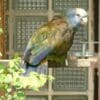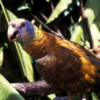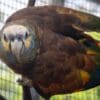St. Vincent Amazon
Also known as:
Guilding's Amazon (Parrot)
Also known as:
Guilding's Amazon (Parrot)
DID YOU KNOW?
The St. Vincent Amazon has two morphs (colourations) – green and orange/brown.

Amazona

guildingii
Size:
41 cm (16 in)
Weight:
660-700 g (23-24.5 oz)
Subspecies including nominate:
One race, 2 morphs-golden brown, green
Colour Adult:
Orange/brown morph-both adults plumage mainly golden/brown, the feathers edged with soft black; buff/white forehead, forecrown and lores to area around eyes, joining orange on hindcrown and forecheeks and throat; purple/blue ear coverts and hindcheeks; nape and hindneck olive/green tinted with blue and edged with black; upper tertiary feathers dark green tinted with brown, lower tertiary feathers dark green tinted with purple/blue, occasionally tipped with yellow; orange carpal edge; outer secondary feathers purple/blue with orange at bases, banded in middle with green; yellow greater underwing coverts and underwings; tail orange at base with broad middle band of dark purple/blue and tipped with orange/yellow. Beak horn in colour tinted with olive/green. Eye ring grey, eye orange.
Green morph-both adults dark green upperparts and lower underparts; green underwing coverts and underwings (flight feathers); tail green at base with broad middle band of purple/blue and tipped with yellow.
Colour Juvenile:
Variable but duller than adult, especially on head. Beak horn-coloured with grey at base of upper mandible. Eye brown.
Call:
Varied calls including yapping cries, loud trumpeting, honking (as in domestic goose), shrieking, squawks, and bubbling sounds. Some calls complex; trills, whistles and shrieks.
More Information:
Content Sources:
The Animal Facts
CITES
BirdLife International
Cornell Lab of Ornithology/Birds of the World
Parrots: A Guide to Parrots of the World, Juniper and Parr, 1998
Parrots: Status Survey and Conservation Plan 2000-2004, Snyder, McGowan, Gilardi and Grajal, 2000.
Parrots of the World, Forshaw and Cooper, 1989. 2010 edition
Parrots of the World, Forshaw, 2006.
Parrots in Aviculture, Low 1992.
Psittacine Aviculture, Schubot, Clubb and Clubb, 1992.
Captive Status:
Rare in captivity.
Longevity:
50-60 yrs
Housing:
Walk- in or suspended aviary minimum 4.5 m (14.7 ft) long.
Diet:
70% of diet fruit and vegetables; sunflower and fattening seeds to a bare minimum; fruit such as: apple, orange, banana, cactus fruits, pomegranates; vegetables such as: carrot, celery, green peas and beans, fresh corn, cooked/sprouted beans and pulses; complete kibble.
Enrichment:
—
Nest Box Size:
Vertical box, 12″ x 12″ x 24″ (30.5 cm x 30.5 cm x 61 cm).
Clutch Size:
2, sometimes 3
Fledging Age:
9-10 weeks
Hatch Weight:
—
Peak Weight:
—
Weaning Weight:
—
World Population:
730 individuals, steadily increasing.
IUCN Red List Status:
Vulnerable
CITES Listing:
Appendix I
Threat Summary:
A BirdLife ‘restricted-range’ species. Affected by hunting for food, trapping for live bird trade and loss of habitat due to forestry and banana cultivation. Also threatened by hurricanes and volcanic eruptions from La Soufrière. Genetic isolation of the separate subpopulations is another cause for concern. The introduced nine-banded armadillo Dasypus novemcinctus undermines large trees causing them to topple, reducing the number of suitable nest trees.
Range:
Restricted to the island of St. Vincent in the Lesser Antilles, West Indes.
Habitat:
Inhabits mature moist forest from 125 to 1000 m (410-3280 ft); occasionally visits cultivated areas and gardens.
Wild Diet:
Fruit and seeds of Pouteria, Dacryodes, Cordia, Krugiodendron, Micropholis, Dussia, Talauma, Inga, Chione, Simaruba, Ixora, Sloanea, Richeria, Psidium, Annona, Calophyllum, Andira, Aiphanes, Cecropia, Meliosma and various palms and figs.
Ecology and Behaviour:
Gregarious and usually in flocks of 20 to 30 birds; otherwise in pairs; birds will defend area around nest while breeding but will allow flocks of a dozen birds to be in the same area while feeding and roosting.
Clutch and Egg Size:
2, sometimes 3 eggs, 46.5 x 39.0 mm (1.8 x 1.5 in).
Breeding Season:
February-June. Nest in tree cavity, notably Dacryodes sp.
Related Links:
—
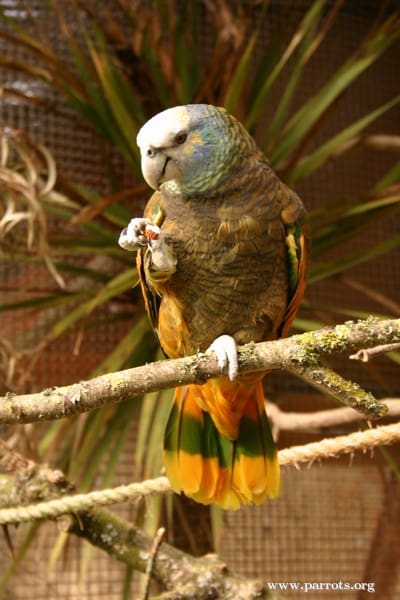
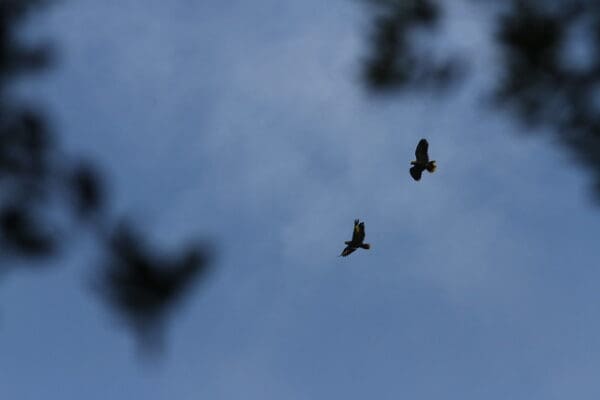
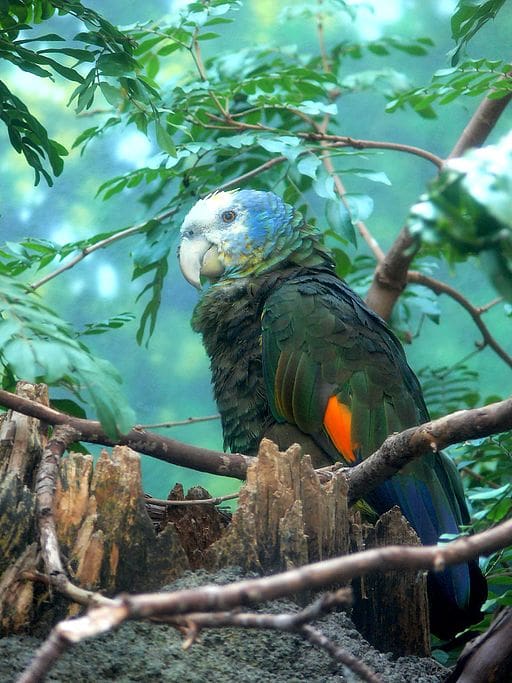
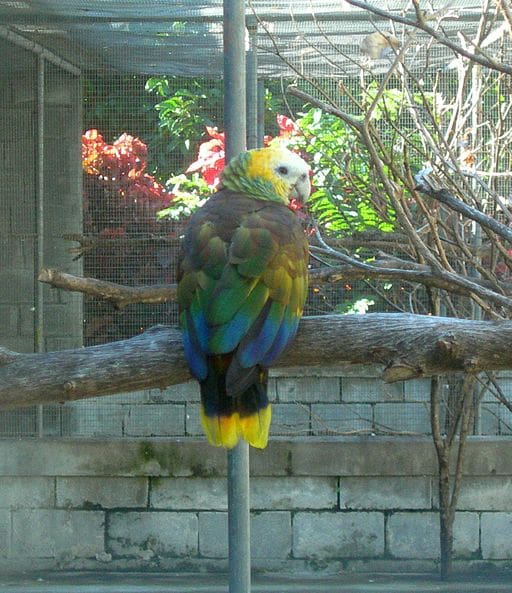

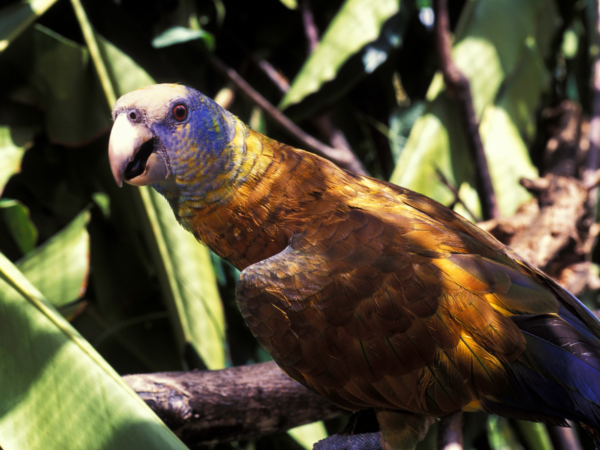
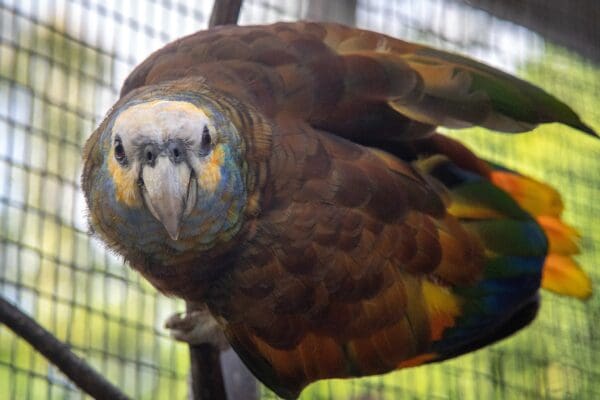
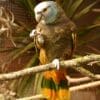
![© Aaron Michael [CC BY-SA 2.0] via Flickr](https://parrots.org/wp-content/uploads/2023/01/wpt_St.-Vincent-Amazon_1090-8-100x100.jpg)
![© Beralpo at ru.wikipedia [CC BY 2.5] via Wikimedia Commons](https://parrots.org/wp-content/uploads/2023/01/wpt_St.-Vincent-Amazon_1090-7-100x100.jpg)
![© Chennette (originally posted to Flickr as vincy parrot) [CC BY-SA 2.0] via Wikimedia Commons A St. Vincent Amazon perches on a branch at a botanical garden on St. Vincent and the Grenadines](https://parrots.org/wp-content/uploads/2023/01/wpt_St.-Vincent-Amazon_1090-6-100x100.jpg)
